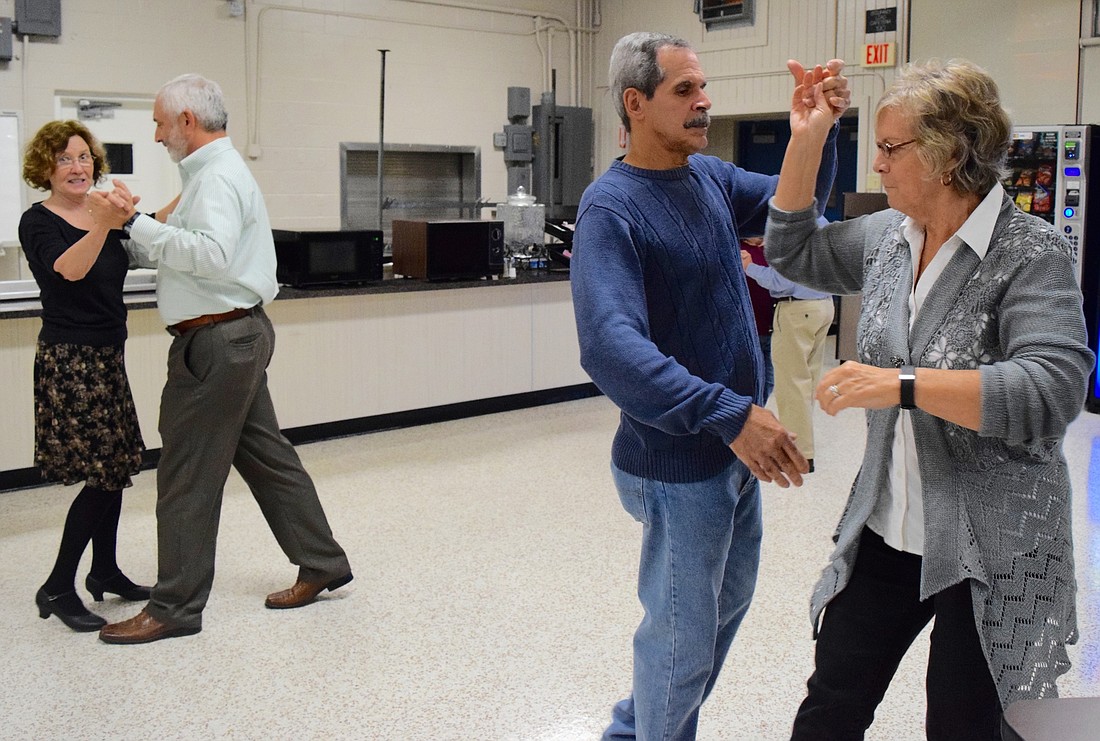- April 22, 2024
-
-
Loading

Loading

WINTER GARDEN “Ladies, which foot do we start off on and why?” Darlene Bienias asks her female students during her beginners ballroom-dancing class.
The women respond in unison: “Right, because we’re always right.”
As her students partner up and dance around Westside Tech’s cafeteria, Bienias walks around observing each couple, offering tips and correcting steps when needed. They start with the foxtrot, then transition to the rumba. Some sway steps make an appearance, and an occasional spin is thrown in.
“I’ve been doing ballroom dancing since about 2000,” Bienias, a certified dance instructor, said. “I always liked dancing … I only had one year of dancing when I was 9 years old, but then my parents couldn’t afford it anymore. But when we settled here, I thought it might be fun to go back to it.”
Through the years, she’s dabbled in various dances, from tap and jazz to hip hop, some ballet and even the Tahitian hula.
“I can’t believe more people don’t come for it. Dancing is like singing; it makes you feel good.”
— Darlene Bienias, ballroom dancing instructorH
“One time I missed my tap class, so I went in for a make-up and they said, ‘Well, you can’t get in on the class today but you can go in on the hip-hop class,’” she said. “So I figured that was better than nothing, so I went in, and I was there for three years.”
Soon after, Bienias met a friend who was taking ballroom dancing and loved it. So she decided to try it for herself and ended up taking lessons for a year at the community center in Apopka.
Eventually, she made her way over to Westside Tech, where she’s been since about 2007. Each spring and fall, there are two seven-week class sessions, with a one-week break in between.
“I can’t believe more people don’t come for it. Dancing is like singing; it makes you feel good,” Bienias said. “People can come in here and maybe they’ve had trouble at work or home, but they can come in here and for an hour they’re thinking about dancing, and by the time they leave, I really believe they all feel happy.”
Although it may not be as strenuous, ballroom dancing is also considered a form of exercise. According to the Livestrong Foundation, 30 minutes of ballroom dancing can burn between 200 and 400 calories. It helps tone and strengthen muscles in the calves, thighs and glutes — and if you’re lifting a partner, it constitutes a good upper-body workout, as well.
Additionally, dancing continuously for 30 to 40 minutes helps condition the cardiovascular system, which results in strengthening the heart, lowering cholesterol and increasing lung capacity. And because ballroom dancing is a weight-bearing exercise, it helps maintain bone density and can help prevent osteoporosis. Bienias added it’s also good for the mind, not only in the release of endorphins but also for memory.
“In ballroom, there’s certain figures, and you put these figures together and you’re dancing away, but you have to remember what you’re going to do next, like ‘Which foot goes where?’” she said.
Another benefit of ballroom dancing is that it is not monotonous, since participants aren’t practicing the same dance over and over again. The following dances are all included under the ballroom category: Foxtrot, rumba, waltz, cha-cha, tango, salsa, Viennese waltz, Bolero, Paso Doble and the quickstep.
“There’s a lot of dances under that ballroom title, so that’s why it takes a while to learn it, because it’s not just one dance, which makes it interesting,” Bienias said. “I just wish more people would give it a shot, just come in and try it. What have you got to lose? You’ve got so much to gain.”
Contact Danielle Hendrix at [email protected].